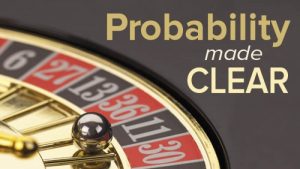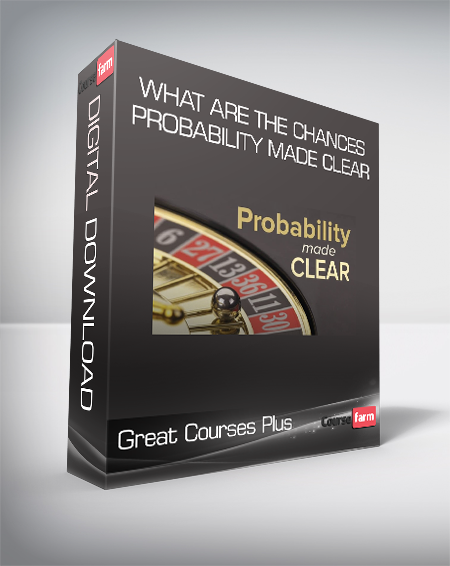Buy Great Courses Plus – What Are The Chances – Probability Made Clear Course at GBesy. We actively participate in Groupbuys and are committed to sharing knowledge with a wider audience. Rest assured, the quality of our courses matches that of the original sale page. If you prefer, you can also buy directly from the sale page at the full price (the SALEPAGE link is directly provided in the post).
We join Groupbuy AND always try to share knowledge with more people. Especially the quality is the same as salepage. You can buy directly at salepage, with full price. (link SALEPAGE are mounted directly on the post)
Great Courses Plus – What Are The Chances – Probability Made Clear

What Are the Chances? Probability Made Clear helps you understand the random factors that lurk behind almost everything—from the chance combinations of genes that produced you to the high odds that the waiting time at a bus stop will be longer than the average time between buses if they operate on a random schedule.
In 12 stimulating half-hour lectures, you will explore the fundamental concepts and fascinating applications of probability.
High Probability You Will Enjoy This Course
Professor Michael Starbird knows the secret of making numbers come alive to non-mathematicians: he picks intriguing, useful, and entertaining examples. Here are some that you will explore in your investigation of probability as a reasoning tool:
- When did the most recent common ancestor of all humans live? Applying probabilistic methods to the observed mutation rate of human genetic material, scientists have traced our lineage to a female ancestor who lived about 150,000 years ago.
- How much should you pay for a stock option? Options trading used to be tantamount to gambling until about 1970, when two economists, Fischer Black and Myron Scholes, found a method to quantify those risks and to create a rational model for options pricing.
- What do you do on third down with long yardage? In football, a pass is the obvious play on third down with many yards to go. Of course, the other team knows that. Probability and game theory help decide when to run with the ball to keep your opponent guessing.
What You Will Learn
The course literally begins with a roll of the dice, as Professor Starbird demonstrates that games of chance perfectly illustrate the basic principles of probability, including the importance of counting all possible outcomes of any random event. In Lecture 2, you probe the nature of randomness, which is famously symbolized by monkeys randomly hitting typewriter keys and creating Hamlet. In Lecture 3, you explore the concept of expected value, which is the average net loss or gain from performing an experiment or playing a game many times. Then in Lecture 4, you investigate the simple but mathematically fertile idea of the random walk, which may seem like a mindless way of going nowhere but which has important applications in many fields.
After this introduction to the key concepts of probability, you delve into the wealth of applications. Lectures 5 and 6 show that randomness and probability are central components of modern scientific descriptions of the world in physics and biology. Lecture 7 looks into the world of finance, particularly probabilistic models of stock and option behavior. Lecture 8 examines unusual applications, including game theory, which is the study of strategic decision-making in games, wars, business, and other areas. Then in Lecture 9 you consider two famous probability puzzles guaranteed to cause a stir: the birthday problem and the Let’s Make a Deal® Monty Hall question.
Finally, Lectures 10–12 cover increasingly sophisticated and surprising results of probabilistic reasoning associated with Bayes theorem. The course concludes with probability paradoxes.
Take the Weather Forecasting Challenge
One of the most familiar experiences of probability that we have on a daily basis is the weather report, with predictions like, “There is a 30 percent chance of rain tomorrow.” But what does that mean? What do you think? Choose one:
- (a) Rain will occur 30 percent of the day.
- (b) At a specific point in the forecast area, for example, your house, there is a 30 percent chance of rain occurring.
- (c) There is a 30 percent chance that rain will occur somewhere in the forecast area during the day.
- (d) 30 percent of the forecast area will receive rain, and 70 percent will not.
- (e) None of the above.
In Lecture 5, Dr. Starbird puts this particular forecast under the microscope to demonstrate that probabilistic statements have very precise meanings that can easily be misinterpreted—or misstated. He explains why the answer is (e) and not one of the other choices. He also explains why the official definition from the National Weather Service is subtly but decidedly wrong.
He even wagers that within five years the phrasing of the official definition will change because somebody at the National Weather Service will hear this lecture!
Games People Play
The formal study of probability was born at the dice table. Gambling continues to provide instructive examples of the principles of chance and probability, including:
- Gambler’s ruin: A random walk is a sequence of steps in which the direction of each step is taken at random. In gambling, the phenomenon assures that a bettor who repeatedly plays the same game with even odds will eventually—and invariably—go broke.
- St. Petersburg paradox: A famous problem in probability involves a hypothetical game supposedly played at a casino in St. Petersburg. Though simple and apparently moderately profitable for the gambler, the expected value of the game is infinite! Yet no reasonable person would pay very much to play it. Why not?
- Gambler’s addiction: Randomness plays a valuable role in reinforcing animal behavior. Changing the reinforcement in an unpredictable, random way leads to behaviors that are retained for a long time, even in the absence of rewards. Applied to humans, this observation may help explain the compulsiveness of some gamblers.
Probability to the Rescue
One approach to probability, developed by mathematician and Presbyterian minister Thomas Bayes in the 18th century, interprets probability in terms of degrees of belief. As new information becomes available, the calculation of probability changes to take account of the new data. The Bayesian view reflects the reality that we adjust our confidence in our knowledge as we gain evidence.
Get Great Courses Plus – What Are The Chances – Probability Made Clear download
The world of fluctuating probabilities, under continual adjustment as new evidence comes to light, captures the way the world works in realms like medicine, where a physician makes a preliminary diagnosis based on symptoms and probabilities, then orders tests, and then refines the diagnosis based on the test results and a new set of probabilities.
If you think about it, it’s also the way you work when you’re on a jury. At the outset, you have a vague impression of the likelihood of guilt or innocence of the defendant. As evidence mounts, you adjust the relative probabilities you assign to each of these verdicts. You may not do a formal calculation, but your informal procedure is nonetheless Bayesian.
Randomness is all around us. “Many or most parts of our lives involve situations where we don’t know what’s going to happen,”; says Professor Starbird. Probability comes to the rescue to describe what we should expect from randomness. It is a powerful tool for dispelling illusions and uncertainty to help us understand the true odds when we roll the dice in the game of life.
-
1Our Random World—Probability Defined
-
2The Nature of Randomness
-
3Expected Value—You Can Bet on It
-
4Random Thoughts on Random Walks
-
5Probability Phenomena of Physics
-
6Probability Is in Our Genes
-
7Options and Our Financial FutureBy characterizing the expected behavior of a stock in the future and describing a probability distribution of its likely future price, mathematicians can quantify sophisticated risks in options contracts. However, the practice can be a very dangerous game.
-
8Probability Where We Don’t Expect It
-
9Probability Surprises
-
10Conundrums of Conditional Probability
-
11Believe It or Not—Bayesian Probability
-
12Probability Everywhere
Buy the Great Courses Plus – What Are The Chances – Probability Made Clear course at the best price at GBesy.. After your purchase, you will get access to the downloads page. You can download all the files associated in your order at here and we will also send a download notification email via your mail.
Unlock your full potential with Great Courses Plus – What Are The Chances – Probability Made Clear courses. our courses are designed to help you excel.
Why wait? Take the first step towards greatness by purchasing Great Courses Plus – What Are The Chances – Probability Made Clear courses today. We offer a seamless and secure purchasing experience, ensuring your peace of mind. With our trusted payment gateways, Stripe and PayPal, you can confidently complete your transaction knowing that your financial information is protected.
Stripe, known for its robust security measures, provides a safe and reliable payment process. With its encrypted technology, your sensitive data remains confidential throughout the transaction. Rest assured that your purchase is protected.
PayPal, a globally recognized payment platform, offers an additional layer of security. With its buyer protection program, you can feel confident in your purchase. PayPal ensures that your financial details are safeguarded, allowing you to focus on your learning journey.
Is it secure? to Use of?
- Your identity is completely confidential. We do not share your information with anyone. So it is absolutely safe to buy the Great Courses Plus – What Are The Chances – Probability Made Clear course.
- 100% Safe Checkout Privateness coverage
- Communication and encryption of sensitive knowledge
- All card numbers are encrypted using AES at relaxation-256 and transmitting card numbers runs in a separate internet hosting atmosphere, and doesn’t share or save any data.
How can this course be delivered?
- After your successful payment this “Great Courses Plus – What Are The Chances – Probability Made Clear course”, Most of the products will come to you immediately. But for some products were posted for offer. Please wait for our response, it might take a few hours due to the time zone difference.
- If this happens, please wait. The technical department will process the link shortly after. You will receive notifications directly by e-mail. We appreciate your wait.
What Shipping Methods Are Available?
- You will receive a download link in the invoice or YOUR ACCOUNT.
- The course link always exists. use your account to login and download the Great Courses Plus – What Are The Chances – Probability Made Clear course whenever you need.
- You only need to visit a single link, and you can get all the Great Courses Plus – What Are The Chances – Probability Made Clear course content at once.
- You can do your learning online. You can be downloaded for better results and can study anywhere on any device. Make sure your system does not sleep during the download.
How Do I Track Order?
- We always notice the status of your order immediately after your payment. After 7 days if there is no download link, the system will automatically complete your money.
- We love to hear from you. Please don’t hesitate to email us with any comments, questions and suggestions.
![GBesy [GB] GBesy [GB]](https://www.gbesy.com/wp-content/uploads/2023/05/gbesy-Logo-full-100.png)



 Purchase this course you will earn
Purchase this course you will earn 




